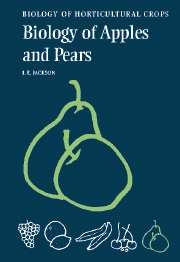Book contents
- Frontmatter
- Contents
- Preface
- Acknowledgements
- Introduction
- 1 The growing of apples and pears
- 2 Apples and pears and their relatives
- 3 Apple and pear root systems: induction, development, structure and function
- 4 The graft union, grafting and budding
- 5 Mechanisms of rootstock and interstock effects on scion vigour
- 6 The shoot system
- 7 Leaves, canopies and light interception
- 8 Photosynthesis, respiration, and carbohydrate transport, partitioning and storage
- 9 Flowers and fruits
- 10 Eating quality and its retention
- 11 Mineral nutrition
- 12 Water relations
- 13 Diseases, pests, and resistance to these
- 14 Biotechnology of apples and pears
- Cultivar Index
- General Index
- References
2 - Apples and pears and their relatives
Published online by Cambridge University Press: 13 August 2009
- Frontmatter
- Contents
- Preface
- Acknowledgements
- Introduction
- 1 The growing of apples and pears
- 2 Apples and pears and their relatives
- 3 Apple and pear root systems: induction, development, structure and function
- 4 The graft union, grafting and budding
- 5 Mechanisms of rootstock and interstock effects on scion vigour
- 6 The shoot system
- 7 Leaves, canopies and light interception
- 8 Photosynthesis, respiration, and carbohydrate transport, partitioning and storage
- 9 Flowers and fruits
- 10 Eating quality and its retention
- 11 Mineral nutrition
- 12 Water relations
- 13 Diseases, pests, and resistance to these
- 14 Biotechnology of apples and pears
- Cultivar Index
- General Index
- References
Summary
Taxonomy
Apples and pears belong to the Rosaceae, subfamily Pomoideae, the pome fruits. Other members of this subfamily include quince and medlar. The flowers of the Rosaceae are actinomorphic with 5 sepals, 5 petals, numerous stamens and either one compound pistil or many simple pistils. The number of styles equals the number of carpels. The Pomoideae have mixed flower buds containing both leaf and flower initials, an epigynous ovary and 2–5 carpels. The Pomoideae have a basic chromosome number of 17 compared with 7–9 for the other subfamilies of Rosaceae.
The Malus (apple) inflorescence is determinate but the descriptive terminology is disputed (Pratt, 1988). It is variously described as a corymb, a corymbose raceme, a cyme and a false cyme. Pyrus (pear) inflorescences have been described as umbel-like simple corymbs (Clapham, Tutin and Warburg, 1952) and as racemes (Bell et al. 1996). Cydonia (quince) flowers are solitary.
The typical apple flower (see also Chapter 9) has 5 petals, varying from white to deep pink, 5 sepals, 20 stamens in three whorls (10 + 5 + 5) with yellow anthers, and a pistil which divides into five styles united at the base. The ovary has 5 locules, each usually containing 2 ovules giving a maximum seed content of 10 although some cultivars may have up to 30 (Janick et al., 1996). P. communis flowers typically have 5, usually white, petals, 5 sepals and 20–30 stamens with red or purple anthers.
- Type
- Chapter
- Information
- The Biology of Apples and Pears , pp. 22 - 83Publisher: Cambridge University PressPrint publication year: 2003
References
- 2
- Cited by



